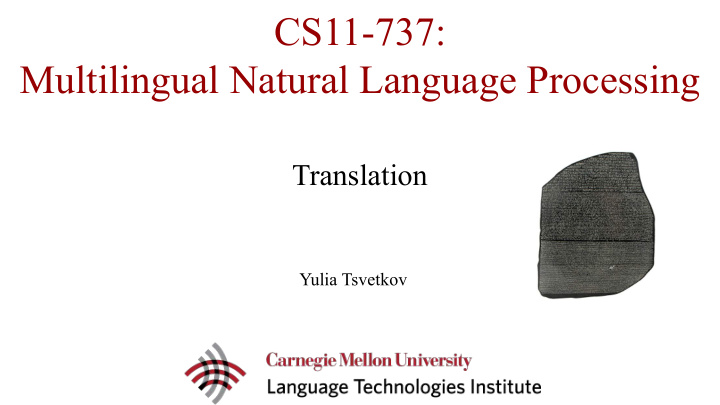



CS11-737: Multilingual Natural Language Processing Translation Yulia Tsvetkov
Translation Mr. and Mrs. Dursley, who lived at El señor y la señora Dursley, que number 4 on Privet Drive, were proud vivían en el número 4 de Privet Drive, to say they were very normal, estaban orgullosos de decir que eran fortunately. muy normales, afortunadamente.
Plan ● The practice of translation ● Machine translation (MT) ● MT data sources ● MT evaluation
Translation is important and ubiquitous
Why is it difficult to translate? ● Lexical ambiguities and divergences across languages [Examples from Jurafsky & Martin Speech and Language Processing 2nd ed.]
Why is it difficult to translate? ● Cross-lingual lexical and structural divergences 錨玉自在枕上感念寶釵。。。又聽見窗外竹梢焦葉之上 , 雨聲漸沂 , 清寒透幕 , 不党又滴下淚來 。 dai yu zi zai zhen shang gan nian bao chai...you ting jian chuang wal zhu shao xiang ye zhe shang, yu sheng xili, qing han tou mu, bu jue you di xia lei lat From “Dream of the Red Chamber” Cao Xue Qin (1792)
Why is it difficult to translate? [Example from Jurafsky & Martin Speech and Language Processing 2nd ed.]
Why is it difficult to translate? ● Ambiguities ○ words ○ morphology ○ semantics ○ pragmatics ● Gaps in data ○ availability of corpora ○ commonsense knowledge ● +Understanding of context, connotation, social norms, etc.
3 Classical methods for MT ● Direct ● Transfer ● Interlingua
The Vauquois triangle (1968)
Direct translation ● Word-by-word dictionary translation ● Rely on linguistic knowledge for simple reordering or morphological processing lexical transfer source target morphological local morphological using bilingual language analysis reordering generation language dictionary text text
Direct MT dictionary entry
Transfer approaches ● Levels of transfer
Transfer approaches ● Syntactic transfer
Transfer approaches ● Syntactic transfer
Transfer approaches ● Syntactic transfer
Transfer approaches ● Semantic transfer
Transfer approaches ● Semantic transfer
Transfer approaches
Interlingua
Learning from data
Parallel corpora
Parallel corpora
Parallel corpora
Parallel corpora
Parallel corpora Mining parallel data from microblogs Ling et al. 2013
opus.nlpl.eu
Is it a good translation?
MT evaluation is hard ● MT Evaluation is a research topic on its own ● Language variability: there is no single correct translation ○ Is system A better than system B? ● Human evaluation is subjective
Human evaluation ● Adequacy and Fluency ○ Usually on a Likert scale (1 “not adequate at all” to 5 “completely adequate”)
Human evaluation ● Ranking of the outputs of different systems at the system level
Human evaluation ● Adequacy and Fluency ○ Usually on a Likert scale (1 “not adequate at all” to 5 “completely adequate”) ● Ranking of the outputs of different systems at the system level ● Post editing effort: how much effort does it take for a translator (or even monolingual) to “fix” the MT output so it is “good” ● Task-based evaluation: was the performance of the MT system sufficient to perform a task.
Automatic evaluation ● Precision-based ○ BLEU , NIST, ... ● F-score-based ○ Meteor,... ● Error rates ○ WER, TER, PER,... ● Using syntax/semantics ○ PosBleu, Meant, DepRef,... ● Embedding based ○ BertScore, chrF, YISI-1, ESIM , ...
Automatic evaluation ● The BLEU score proposed by IBM (Papineni et al., 2002) ○ Count n-grams overlap between machine translation output and reference reference translations ○ Compute precision for ngrams of size 1 to 4 ○ No recall (because difficult with multiple references) ○ To compensate for recall: “brevity penalty”. Translations that are too short are penalized ○ Final score is the geometric average of the n-gram precisions, times the brevity penalty ○ Calculate the aggregate score over a large test set
BLEU vs. human judgments
Automatic evaluation ● Embedding based ○ BertScore, chrF, YISI-1, ESIM , ...
MT venues and competitions ● MT tracks in *CL conferences ● WMT , IWSLT, AMTA... ● www.statmt.org
Class discussion ● Pick a 4-line excerpt from a poem in English ● Use Google translate to back-translate the poem via a pivot language, e.g., ○ English → Spanish → English ○ English → L1 → L2 → English, where L1 and L2 are typologically different from English and from each other ● Compare the original poem and its English back-translation, and share your observations. For example, ○ what information got lost in the process of translation? ○ Are there translation errors associated with linguistic properties of pivot languages and with linguistic divergences across languages? ○ Try different pivot languages: can you provide insights about the quality of MT for those language pairs?
Recommend
More recommend